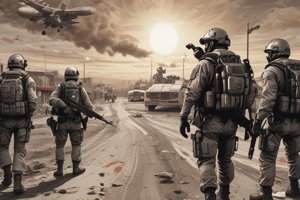Podcast
Questions and Answers
What is a key objective of terrorism response for EMS personnel?
What is a key objective of terrorism response for EMS personnel?
- Creating panic among the public
- Ensuring personal and public safety (correct)
- Avoiding patient care
- Ignoring personal safety
What is a common characteristic of terrorist incidents?
What is a common characteristic of terrorist incidents?
- Planned events designed to cause mass casualties (correct)
- Unintentional events
- Naturally occurring disasters
- Spontaneous gatherings
Which of the following is a key indicator of a possible terrorist event?
Which of the following is a key indicator of a possible terrorist event?
- Small number of patients with varied symptoms
- Unexplained mass casualties (correct)
- Calm and orderly scene
- An abundance of resources
What is the first priority in a terrorist response?
What is the first priority in a terrorist response?
Why must EMS personnel work within the Incident Command System (ICS) during a terrorist event?
Why must EMS personnel work within the Incident Command System (ICS) during a terrorist event?
What should EMS personnel assume when approaching a scene in a potential terrorist attack?
What should EMS personnel assume when approaching a scene in a potential terrorist attack?
What is the role of the Incident Commander (IC) in the Incident Command System?
What is the role of the Incident Commander (IC) in the Incident Command System?
Which team manages patient care in the Incident Command System?
Which team manages patient care in the Incident Command System?
Which type of agent uses infectious agents to cause widespread disease?
Which type of agent uses infectious agents to cause widespread disease?
What is a common symptom of exposure to Anthrax or Plague?
What is a common symptom of exposure to Anthrax or Plague?
What is the key treatment for exposure to Botulinum toxin?
What is the key treatment for exposure to Botulinum toxin?
What is one key characteristic of chemical attacks?
What is one key characteristic of chemical attacks?
SLUDGE symptoms are associated with which type of nerve agent?
SLUDGE symptoms are associated with which type of nerve agent?
What is a primary effect of exposure to blood agents, like Cyanide?
What is a primary effect of exposure to blood agents, like Cyanide?
What is the immediate treatment for victims exposed to choking agents?
What is the immediate treatment for victims exposed to choking agents?
What is the main effect of radiological/nuclear agents on victims?
What is the main effect of radiological/nuclear agents on victims?
What is the primary cause of a primary blast injury?
What is the primary cause of a primary blast injury?
In the START triage system, what color tag is assigned to patients with minor injuries?
In the START triage system, what color tag is assigned to patients with minor injuries?
What does Level A PPE provide?
What does Level A PPE provide?
What is an important decontamination step?
What is an important decontamination step?
Flashcards
Terrorist incidents
Terrorist incidents
Intentional, planned events designed to cause mass casualties, panic, and infrastructure disruption.
Key Indicators of a Terrorist Event
Key Indicators of a Terrorist Event
Unexplained mass casualties, similar symptoms, unusual signs, explosions, sick animals, unusual dissemination, specific threats.
Terrorist response priority
Terrorist response priority
Ensuring scene safety.
Incident Commander (IC)
Incident Commander (IC)
Signup and view all the flashcards
Operations Section
Operations Section
Signup and view all the flashcards
Hazmat Team
Hazmat Team
Signup and view all the flashcards
Triage and Treatment Teams
Triage and Treatment Teams
Signup and view all the flashcards
Logistics and Communication
Logistics and Communication
Signup and view all the flashcards
Bacterial Agents (Anthrax, Plague)
Bacterial Agents (Anthrax, Plague)
Signup and view all the flashcards
Viral Agents (Smallpox, Viral Hemorrhagic Fevers)
Viral Agents (Smallpox, Viral Hemorrhagic Fevers)
Signup and view all the flashcards
Toxins (Botulinum toxin, Ricin)
Toxins (Botulinum toxin, Ricin)
Signup and view all the flashcards
Nerve Agents (Sarin, VX)
Nerve Agents (Sarin, VX)
Signup and view all the flashcards
Blister Agents (Mustard gas, Lewisite)
Blister Agents (Mustard gas, Lewisite)
Signup and view all the flashcards
Blood Agents (Cyanide, Arsine)
Blood Agents (Cyanide, Arsine)
Signup and view all the flashcards
Choking Agents (Chlorine, Phosgene)
Choking Agents (Chlorine, Phosgene)
Signup and view all the flashcards
Radiation Exposure
Radiation Exposure
Signup and view all the flashcards
Primary Blast Injury
Primary Blast Injury
Signup and view all the flashcards
Secondary Blast Injury
Secondary Blast Injury
Signup and view all the flashcards
Quaternary Blast Injury
Quaternary Blast Injury
Signup and view all the flashcards
Immediate (Red) Triage Category
Immediate (Red) Triage Category
Signup and view all the flashcards
Study Notes
Terrorism Response Overview
- EMS personnel require terrorism response training to recognize incidents, ensure safety, and administer patient care while maintaining situational awareness.
- Focus is placed on terrorist events, response priorities, and CBRNE (chemical, biological, radiological, nuclear, and explosive) incident management.
Recognizing Terrorist Events
- Terrorist incidents are planned to cause mass casualties, panic, and infrastructure disruption.
- Indicators include unexplained mass casualties; similar symptoms in many patients (respiratory distress, burns, neurological impairment); unusual odors, vapors, or visible clouds; explosions or suspicious devices; multiple sick or dying animals; unusual dissemination methods (aerosols, contaminated food/water); and specific threats or warnings.
Scene Safety and Incident Command System (ICS)
- Ensuring scene safety is the first priority.
- EMS must work within the ICS to coordinate an organized, efficient response.
Scene Safety Guidelines
- Approach cautiously, assuming secondary devices or ongoing threats are present.
- Establish a safe zone, avoiding hazardous areas without proper training.
- Wear appropriate PPE, with the level determined by the agent involved.
- Report findings to law enforcement and hazmat teams.
- Avoid contamination by minimizing exposure and preventing secondary contamination.
ICS Roles in Terrorism Response
- Incident Commander (IC) coordinates response efforts.
- Operations Section directs tactical and medical operations.
- Hazmat Team identifies and mitigates hazardous agents.
- Triage and Treatment Teams manage patient care.
- Logistics and Communication coordinate resource deployment and information flow.
Biological Agents
- Biological attacks use infectious agents, causing widespread disease with potentially delayed symptoms.
- Bacteria examples: Anthrax, Plague transmitted through inhalation, ingestion, or direct contact, causing respiratory distress, fever, or sepsis; treated with antibiotics
- Viruses examples: Smallpox, Viral hemorrhagic fevers spread via aerosolized or person-to-person contact, causing fever, rash, or hemorrhage; treated with supportive care and isolation.
- Toxins examples: Botulinum toxin and Ricin spread via ingestion or inhalation, causing paralysis or respiratory failure; treated with antitoxins and supportive care.
- Recognition is difficult because symptoms can mimic common illnesses.
- Containment is critical, involving infection control, isolation, and PPE (N95 mask, gloves, gown).
- Public Health Authorities must be notified to prevent the spread.
Chemical Agents
- Chemical attacks cause rapid symptoms, requiring immediate decontamination and supportive care.
- Nerve Agents: Sarin, VX, Tabun cause SLUDGE symptoms (Salivation, Lacrimation, Urination, Defecation, GI upset, Emesis) and seizures; treated with Atropine & Pralidoxime (2-PAM) and airway management.
- Blister Agents: Mustard gas and Lewisite cause severe burns, blisters, and respiratory distress; treated with airway support, pain management, and irrigation.
- Blood Agents: Cyanide and Arsine cause cellular hypoxia and respiratory arrest; treated with Hydroxocobalamin (Cyanokit) and high-flow O2.
- Choking Agents: Chlorine and Phosgene cause pulmonary edema and dyspnea; treated with oxygen and bronchodilators.
- Decontamination requires clothing removal and skin flushing with water, rapid transport is essential
Radiological/Nuclear Agents
- Radiological/nuclear attacks expose victims to radiation, causing acute radiation syndrome (ARS), burns, and long-term cancer risks.
- Dirty bombs and nuclear reactor incidents cause nausea, vomiting, burns, and pancytopenia.
- Treatment involves decontamination, potassium iodide, and supportive care.
- Limit exposure through time, distance, and shielding.
- Remove clothing and wash with soap/water as part of decontamination.
- Monitor for ARS, as symptoms progress over hours to days.
Explosive and Incendiary Devices
- Explosives cause blast injuries, including blunt trauma, burns, and penetrating wounds.
- Primary Blast Injury: Shockwave causes lung injury (blast lung), eardrum rupture, and bowel perforation.
- Secondary Blast Injury: Shrapnel and debris cause lacerations, fractures, and amputations.
- Tertiary Blast Injury: Body displacement causes blunt trauma and spinal injuries.
- Quaternary Blast Injury: Burns, asphyxiation, and toxic inhalation cause thermal and crush injuries.
- Expect multiple casualties.
- Beware of secondary devices.
- Rapid trauma care involves controlling hemorrhage and providing airway support and transport.
EMS Response and Triage in Terrorist Incidents
- Mass casualty incidents (MCIs) use triage to prioritize treatment.
- Immediate (Red): Respiratory distress, major bleeding, severe burns require immediate attention (high priority).
- Delayed (Yellow): Moderate injuries and closed fractures require delayed treatment (medium priority).
- Minor (Green): Walking wounded and minor cuts require minimal treatment (low priority).
- Expectant (Black): Cardiac arrest and massive head trauma receive no treatment.
START Triage
- Simple Triage and Rapid Treatment:
- If the patient can walk, they are triaged as Green.
- If the patient is not breathing, attempt to reposition the airway; if still not breathing, triage as Black
START Triage Continued
- Respiratory Rate >30? Red
- Radial Pulse Absent? → Red
- Unable to follow commands? → Red
Personal Protective Equipment (PPE) and Decontamination
- Proper PPE minimizes responder risk.
- Level A: Fully encapsulated, self-contained breathing apparatus (SCBA) - Highest protection.
- Level B: Non-encapsulated, SCBA - High respiratory protection.
- Level C: Air-purifying respirator (APR), splash protection.
- Level D: Standard PPE (gloves, eye protection).
Decontamination Steps
- Remove clothing (reduces contamination by 80-90%).
- Rinse skin with water/soap.
- Use decon corridors before hospital transport.
Conclusion
- Vigilance in identifying terrorist events, prioritizing scene safety, and delivering effective medical care is crucial for EMS responders.
- Awareness of CBRNE agents, appropriate PPE use, and adherence to ICS protocols ensures an organized and safe response.
Studying That Suits You
Use AI to generate personalized quizzes and flashcards to suit your learning preferences.




